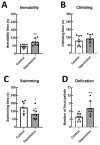Stress-Induced Depression and Its Effects on Tooth Wear in Rats: A 3D Dental Scan Imaging Perspective
- PMID: 40430140
- PMCID: PMC12113425
- DOI: 10.3390/life15050712
Stress-Induced Depression and Its Effects on Tooth Wear in Rats: A 3D Dental Scan Imaging Perspective
Abstract
Background: In addition to behavioral and biochemical abnormalities, a parafunction associated with temporomandibular joint disorders (TMDs) resulted in stress-induced depression in rats. Exploring how chronic stress influences molar wear in rodents provides insights into the understanding of depression, TMD, and oral health. This study aimed to conduct a three-dimensional (3D) analysis of first molar wear in an animal model of depression by comparing molar attrition and cusp variation between stressed male rats and control groups.
Methods: After obtaining a validated model of depression in male rats, we obtained 3D scans of lower molars to analyze wear patterns. The 3D analysis was applied to quantify cusps' volume and the difference in first molar cusp morphological structure. The data were then compared to identify significant morphological differences between groups side by side.
Results: The analysis revealed the reduction of cusps' volume in the depression groups. Rats exposed to depression exhibited significantly greater occlusal table wear than their control counterparts (p < 0.05).
Conclusions: As dentistry moves towards greater digital imaging, understanding the impact of psychological factors on TMD becomes increasingly necessary. This study shows that stress-induced depression in rats can result in significant tooth wear, as investigated using a 3D dental scanner.
Keywords: bruxism; dental digital scanner; depression; restraint stress; temporomandibular disorder; three-dimensional analysis; tooth wear.
Conflict of interest statement
The authors declare no conflicts of interest.
Figures








Similar articles
-
The association between wear facets, bruxism, and severity of facial pain in patients with temporomandibular disorders.J Prosthet Dent. 2003 Aug;90(2):194-200. doi: 10.1016/s0022-3913(03)00332-9. J Prosthet Dent. 2003. PMID: 12886214
-
3D printed versus milled stabilization splints for the management of bruxism and temporomandibular disorders: study protocol for a randomized prospective single-blinded crossover trial.Trials. 2024 Sep 5;25(1):589. doi: 10.1186/s13063-024-08437-7. Trials. 2024. PMID: 39238023 Free PMC article.
-
Variability in molar crown morphology and cusp wear in two Western chimpanzee populations.Am J Biol Anthropol. 2023 May;181(1):29-44. doi: 10.1002/ajpa.24707. Epub 2023 Feb 21. Am J Biol Anthropol. 2023. PMID: 36807569
-
Oral splints for patients with temporomandibular disorders or bruxism: a systematic review and economic evaluation.Health Technol Assess. 2020 Feb;24(7):1-224. doi: 10.3310/hta24070. Health Technol Assess. 2020. PMID: 32065109 Free PMC article.
-
Associations between tooth wear and dental sleep disorders: A narrative overview.J Oral Rehabil. 2019 Aug;46(8):765-775. doi: 10.1111/joor.12807. Epub 2019 May 12. J Oral Rehabil. 2019. PMID: 31038764 Free PMC article. Review.
References
-
- Major Depression—National Institute of Mental Health (NIMH) [(accessed on 5 March 2025)]; Available online: https://www.nimh.nih.gov/health/statistics/major-depression.
-
- Institute for Health Metrics and Evaluation Global Health Data Exchange (GHDx) [(accessed on 5 March 2025)]. Available online: https://vizhub.healthdata.org/gbd-results.
-
- Evans-Lacko S., Aguilar-Gaxiola S., Al-Hamzawi A., Alonso J., Benjet C., Bruffaerts R., Chiu W.T., Florescu S., de Girolamo G., Gureje O., et al. Socio-Economic Variations in the Mental Health Treatment Gap for People with Anxiety, Mood, and Substance Use Disorders: Results from the WHO World Mental Health (WMH) Surveys. Psychol. Med. 2018;48:1560–1571. doi: 10.1017/S0033291717003336. - DOI - PMC - PubMed
Grants and funding
LinkOut - more resources
Full Text Sources
Research Materials

